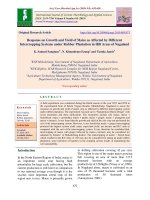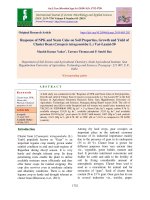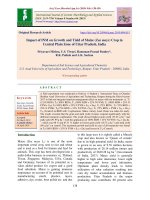Growth and yield of finger millet (Eleusine coracana L. Gaertn.) as influenced by intercropping with pulses
Bạn đang xem bản rút gọn của tài liệu. Xem và tải ngay bản đầy đủ của tài liệu tại đây (337.44 KB, 7 trang )
Int.J.Curr.Microbiol.App.Sci (2020) 9(8): 2297-2303
International Journal of Current Microbiology and Applied Sciences
ISSN: 2319-7706 Volume 9 Number 8 (2020)
Journal homepage:
Original Research Article
/>
Growth and Yield of Finger Millet (Eleusine coracana L. Gaertn.) as
Influenced by Intercropping with Pulses
Dhimmagudi Ramamohan Reddy1*, P. Shalini Pillai1, Jacob John2,
A. Sajeena2 and J. C. Aswathy1
1
Department of Agronomy, Kerala Agricultural University, College of Agriculture,
Vellayani, Thiruvananthapuram, Kerala, India
2
Kerala Agricultural University, Integrated Farming System Research Station,
Karamana, Thiruvananthapuram, Kerala, India
*Corresponding author
ABSTRACT
Keywords
Finger millet
Eleusine coracana,
Arbuscular
mycorrhizal fungi
Article Info
Accepted:
20 July 2020
Available Online:
10 August 2020
A study was conducted at Integrated Farming System Research Station, Karamana,
Thiruvananthapuram, Kerala, to assess the effect of intercropping in finger millet and to
assess the effect of AMF on the growth and yield of finger millet. The field experiment
was laid out in randomized block design with 11 treatments replicated thrice. The
treatments comprised finger millet (with and without AMF) intercropped with pulses, viz.,
green gram, black gram and cowpea along with the sole crop of all the above crops. The
results elicited that both AMF and intercropping had significant effect on the growth and
yield of finger millet. The sole crop of finger millet with AMF was found to show superior
growth and yield attributes of finger millet. Among the intercropping systems, finger
millet (with AMF) + cowpea was found to excel in the growth and yield.
Introduction
Millets are regarded as one of the ancient
foods known to mankind. The hardy nature of
millets has gained them the recognition as the
staple food of people living in the drier parts
of the world. Millets are also known as
‘famine reserves’ due to their prolonged shelf
life of more than two years without
deterioration (Sahu and Sharma, 2013).
Further, millets are nutritionally comparable
or even superior to rice and wheat with
respect to protein, energy, vitamins, and
minerals (Sehgal and Kawatra, 2003). Thus,
millets which were once christened as poor
man’s food is acquiring acceptance in the
food basket of the rich as the keystone
towards a healthy and sustainable food
revolution. Finger millet (Eleusine coracana
(L.) Gaertn) is cultivated in the tropical and
subtropical regions, has been reported to
thrive on hardly 28 per cent of the water
requirement of rice (Triveni et al., 2017).
India, finger millet occupied an area of 1.19
million hectares accounting for a production
of 1.98 million tonnes and an average
2297
Int.J.Curr.Microbiol.App.Sci (2020) 9(8): 2297-2303
productivity of 1661 kg ha-1 (Sakamma et al.,
2018). As for Kerala, finger millet was
reported in an area of 33 ha covering the
districts of Palakkad and Idukki with a
production of 42 t (FIB, 2019).
The ever-shrinking per capita land availability
warrants both temporal and spatial
intensification of agricultural systems (Kiwia
et al., 2019). Crop diversification through
intercropping has been acknowledged as a
principal pillar for ensuring sustainable
development. Crops which vary in their
growth habits are grown together so that they
complement one another resulting in higher
resource use efficiency. Legumes assume
paramount importance in intercropping
systems involving cereals / millets because of
their ability to fix and transfer nitrogen. Sole
cropping of millets like finger millet is
usually not appreciably remunerative and it
fails to satisfy the diverse consumer demand.
The initial slow growth phase of finger millet
can be utilized for raising short duration
pulses. Moreover, intercropping with fast
growing pulses will also help in reducing the
weed problems. Combining intercropping
with biofertilization has been observed to
enhance crop productivity and soil fertility.
Linking cereal – legume intercropping
through common mycorrhizal network
improves the productivity of crops
(Hauggaard-Nielsen and Jensen, 2005).
Hence, the study entitled was undertaken to
assess the productivity of intercropping finger
millet with pulses, to study the effect of AMF
on the performance of finger millet under
intercropping and to work out the land
equivalent ratio (LER).
Materials and Methods
A field experiment was conducted at
Integrated Farming System Research Station,
Karamana, Thiruvananthapuram, Kerala,
during the summer 2019 - 2020 where finger
millet variety PPR 2700, was intercropped
with pulses, viz., green gram (CO 8), black
gram (DU 1) and cowpea (Kanakamony), in
the ratio 4:1. Finger millet was raised with
and without arbuscular mycorrhizal fungi
(AMF), which was obtained from the
Department of Agricultural Microbiology,
College of Agriculture, Vellayani. The
experiment was laid out in randomized block
design with 11 treatments replicated three
times. Arbuscular mycorrhizal fungi (AMF)
were applied to finger millet at the time of
sowing. The treatments comprised of finger
millet (with or without) intercropped with
pulses, viz., green gram, black gram and
cowpea and the sole crop of all the four
mentioned crops. The soil of the experimental
site was sandy clay loam in texture, strongly
acidic in reaction, high in organic carbon, low
in available nitrogen and medium in available
phosphorus and potassium status. The data
generated were statistically analysed using
analysis of variance technique (ANOVA), as
applied to randomized block design (Gomez
and Gomez, 2010).
Results and Discussion
Growth and Growth Attributes
The results of the study revealed that
intercropping had significant effect on the
growth and growth attributes of finger millet.
The effect of intercropping on plant height
and LAI of finger millet exhibited
significance only at 30 DAS. The tiller count
was observed to vary significantly with
intercropping at 30 and 60 DAS whereas dry
matter production varied significantly at 30
and 60 DAS as well as at harvest (Table 1 and
2). Among the intercropping systems, T8
(finger millet with AMF + cowpea) registered
the highest dry matter production. The higher
LAI, tiller count, crop growth rate and relative
growth rate supported by this treatment might
have contributed to the higher dry matter
2298
Int.J.Curr.Microbiol.App.Sci (2020) 9(8): 2297-2303
production. Dry matter production and light
interception are directly related and light
interception is mainly dependent on the LAI
(Ewert, 2004; Portes and de Melo, 2014).
Crop growth rate of finger millet was
significantly higher in sole crop of finger
millet with AMF (T2), both at 30 to 60 DAS
(6.373 g m-2 day) and 60 DAS to harvest
(5.830 g m-2 day). Similar trend was observed
with relative growth rate also (Table 3).
Between the sole crops of finger millet,
without and with AMF (T1 and T2), growth
attributes such as plant height, tillers per
plant, LAI, total dry matter production, crop
growth rate and relative growth rate were
observed to be significantly higher with
application of AMF. The total dry matter
produced by finger millet at harvest was 16.9
per cent higher with AMF. Irrespective of the
pulse intercropped, AMF improved the
growth attributes of finger millet. Arbuscular
mycorrhizal fungi have been reported to
possess consistent impact on stomatal
conductance, transpiration, CO2 exchange,
photosynthesis and chlorophyll content
(Panwar, 1991) and consequently plant
growth. Inoculating AMF has been observed
to result in significant increase in growth rate
and dry matter production of crops
(Mudalagiriyappan et al., 1997). Increases in
crop growth rate and relative growth rate are
mainly mediated by an increase in leaf area
index and consequent improvement in
radiation use efficiency. Similar results have
been reported by Chavan et al., (2019).
Yield of Finger Millet
Grain yield and straw yield were superior for
sole crop of finger millet treated with AMF
(T2) compared to that without AMF (T1) (Fig.
1). Inoculation with AMF was observed to
improve the yield of finger millet
intercropped with green gram, black gram and
cowpea. Compared to sole crop, yield
reduction of finger millet (without AMF) was
to the tune of 20.01, 24.05 and 16.38 percent
respectively with green gram, black gram and
cowpea. However, the same with AMF was
only 10.42, 11.36 and 7.01 per cent. This
shows the effect of AMF in enhancing
competitive ability of finger millet under
intercropped situation.
Table.1 Effect of intercropping on plant height and tillers per plant of finger millet
Treatment
T1 : Finger millet as sole crop (without AMF)
T2 : Finger millet as sole crop (with AMF)
T3: Finger millet (without AMF) + green gram
T4 : Finger millet (with AMF) + green gram
T5: Finger millet (without AMF) + black gram
T6 : Finger millet (with AMF) + black gram
T7 : Finger millet (without AMF) + cowpea
T8 : Finger millet (with AMF) + cowpea
T9 : Green gram as sole crop
T10: Black gram as sole crop
T11: Cowpea as sole crop
SE m (±)
CD (0.05)
Plant height (cm)
30
60
At
DAS
DAS
harvest
17.62
63.00
91.77
17.81
67.06
90.36
15.69
59.78
92.87
17.78
65.66
97.14
15.80
63.93
94.08
17.17
67.16
97.90
17.33
65.51
93.45
16.95
68.56
90.08
0.45
2.84
2.33
1.375 NS
NS
2299
Tillers per plant (nos)
30
60
At
DAS
DAS
harvest
1.37
3.20
5.00
2.47
3.97
5.83
1.80
3.50
5.40
1.87
3.77
5.67
1.23
3.13
5.07
1.97
3.43
5.30
1.73
3.53
5.46
2.47
4.40
5.40
0.19
0.22
0.23
0.588 0.660 NS
Int.J.Curr.Microbiol.App.Sci (2020) 9(8): 2297-2303
Table.2 Effect of intercropping on leaf area index and total dry matter production of finger millet
Treatment
T1 : Finger millet as sole crop (without
AMF)
T2 : Finger millet as sole crop (with
AMF)
T3: Finger millet (without AMF) + green
gram
T4 : Finger millet (with AMF) + green
gram
T5: Finger millet (without AMF) + black
gram
T6 : Finger millet (with AMF) + black
gram
T7 : Finger millet (without AMF) +
cowpea
T8 : Finger millet (with AMF) + cowpea
T9 : Green gram as sole crop
T10: Black gram as sole crop
T11: Cowpea as sole crop
SE m (±)
CD (0.05)
Leaf area index
30 DAS 60 DAS At harvest
0.75
2.47
3.18
Total dry matter production (kg ha-1)
30 DAS 60 DAS
At harvest
1005
3355
4942
0.80
3.01
3.87
1174
3921
5775
0.62
2.11
3.08
810
2705
3984
0.68
2.38
3.18
908
3034
4469
0.60
2.23
2.89
770
2572
3788
0.64
2.32
3.25
898
2999
4417
0.65
2.50
3.09
847
2828
4165
0.57
0.041
0.126
2.30
0.25
NS
2.93
0.24
NS
942
15
45.2
3148
49
150.5
4635
72
221.4
NS – Not significant
Table.3 Effect of intercropping on crop growth rate and relative growth rate of finger millet
Treatment
T1 : Finger millet as sole crop (without AMF)
T2 : Finger millet as sole crop (with AMF)
T3: Finger millet (without AMF) + green gram
T4 : Finger millet (with AMF) + green gram
T5: Finger millet (without AMF) + black gram
T6 : Finger millet (with AMF) + black gram
T7 : Finger millet (without AMF) + cowpea
T8 : Finger millet (with AMF) + cowpea
T9 : Green gram as sole crop
T10: Black gram as sole crop
T11: Cowpea as sole crop
SE m (±)
CD (0.05)
2300
Crop growth rate
(g m-2 day-1)
30 – 60 60 DAS
DAS
to harvest
5.337
5.257
6.373
5.830
4.500
4.693
4.797
5.383
4.690
4.543
4.993
4.197
4.733
4.340
4.807
4.530
1.352
0.328
1.0771
1.0030
Relative growth
rate (g g-1 day-1)
30 – 60 60 DAS
DAS
to harvest
0.307
0.182
0.414
0.275
0.325
0.174
0.347
0.183
0.313
0.161
0.350
0.175
0.337
0.197
0.377
0.246
0.005
0.004
0.0162
0.0151
Int.J.Curr.Microbiol.App.Sci (2020) 9(8): 2297-2303
Fig.1 Effect of intercropping on the grain yield and straw yield of finger millet, t ha-1
Fig.2 Effect of intercropping on land equivalent ratio
The increase in productivity, in response to
AMF has been mainly attributed to the ability
of AMF in enhancing the uptake of relatively
immobile nutrients clubbed together with the
rapid translocation of the mobile nutrients
(Tobar et al., 1994; Liu et al., 2000).
be attributed to the role of AMF in promoting
inter-specific root interactions between finger
millet and pulses, effecting nutrient
mobilization in the rhizosphere (Wasaki et al.,
2003), resulting in better growth and
productivity of finger millet.
Among the intercropping systems, T8 (finger
millet with AMF + cowpea) recorded
superiority in yield attributes and yield. This
might be due to a better complementarity
between finger millet and cowpea in utilizing
the basic resources like water, nutrients and
sunlight, as suggested by Kumar and Ray
(2020). The positive impact of AMF in
improving the yield attributes of finger millet
was observed across all the intercropping
systems, irrespective of the pulse. This could
Land Equivalent Ratio
Land equivalent ratio (LER) is the relative
area required under sole cropping to produce
the yield realized under intercropping. LER
values greater than unity denotes yield
advantage. Intercropping finger millet
(without AMF) + cowpea (T7) recorded the
highest LER (1.59), followed by T8 (finger
millet with AMF + cowpea) (Fig. 2).
Intercropping finger millet with green gram
2301
Int.J.Curr.Microbiol.App.Sci (2020) 9(8): 2297-2303
recorded an LER of 1.38 and 1.37
respectively for finger millet without AMF
(T3) and finger millet with AMF (T4).
Comparatively, LER was lower for
intercropping black gram in finger millet.
The general observation was that LER which
is based on the actual crop yields were greater
than unity, signifying that all three intercrops,
viz., green gram, black gram and cowpea were
capable of utilizing the available resources
efficiently than expected, compared to their
respective sole crop yields. According to
Vandermeer (1989), intercrops that result in
LER values greater than unity are considered
to over yield, gaining their advantage through
the ‘competitive production principle’ and/or
the ‘facilitative production principle’. The
higher LER in intercropping than sole
cropping could be attributed to the better
utilization of both natural and supplemented
resources.
In conclusion from the above study it was
evident that the application of AMF on finger
millet had a positive effect on the growth and
yield of finger millet. Further, the
intercropping in finger millet with pulses viz.
green gram, black gram and cowpea which
was indicated by the LER greater than one.
Among
the
intercropping
systems,
intercropping finger millet with cowpea along
with AMF application was found to be
remunerative.
References
Chavan, I.B., Jagtap, D.N., and Mahadkar,
U.V. 2019. Yield and quality of finger
millet (Eleusine coracana L. Gaertn.)
influenced
due
to
different
establishment techniques, levels and
times of nitrogen. Adv. Agric. Res.
Technol. J. 3(2): 191-200.
Ewert, F. 2004. Modelling plant responses to
elevated CO2; how important is the leaf
area index? Ann. Bot. 93(6): 619-627.
FIB [Farm Information Bureau]. 2019. Farm
Guide 2019. Agriculture Development
and Farmers’ Welfare Department,
Government of Kerala, Kowdiar,
Thiruvananthapuram, 294p.
Hauggaard-Nielsen, H. and Jensen, E. S.
2005. Facilitative root interactions in
intercrops. Plant Soil 274: 237–250.
Kiwia, A., Kimani, D., Harawa, R., Jama, B.,
and Sileshi, G.W. 2019. Sustainable
intensification
with
cereal-legume
intercropping in eastern and southern
Africa. Sustainability 11: 1-18.
Kumar, B. and Ray, P.K. 2020. Finger millet
intercropping with legumes step towards
increasing farmer’s income. Int J.
Chem. Studies 8(3): 1038-1040.
Liu A., Hamel C., Hamilton R. I., and Smith
D. L. 2000. Mycorrhizae formation and
nutrient uptake of new corn (Zea mays
L.) hybrids with extreme canopy and
leaf architecture as influenced by soil N
and P levels. Plant Soil 221: 157-166.
Mudalagiriyappan, C.A., Agasimani, K.K.,
Veeranna, S., and Najappa, H.V. 1997.
Nutrient recovery and balance sheet of
nitrogen and phosphorus as influenced
by sources of phosphate solubilizers and
phosphate on groundnut. Mysore. J. Bot.
32: 143-148.
Panwar, J.D.S. 1991. Effect of Azospirillum
brasilense and arbuscular mycorrhizal
fungi on photosynthesis, nitrogen
metabolism and grain yield in wheat.
Indian.J.Pl.Physiol. 34(4):357-361.
Portes, T.D. and de Melo, H.C. 2014. Light
interception, leaf area and biomass
production as a function of density of
maize
plants
analysed
using
mathematical models. Acta Sci. Agron.
36(4): 346-367.
Sahu, R.K. and Sharma, M.L. 2013. Medical
and other use of small millets by the
tribal
farmers of the Bastar plateau
Zone of Chhattisgarh. Ambio. 8(4): 596-
2302
Int.J.Curr.Microbiol.App.Sci (2020) 9(8): 2297-2303
599.
Sakamma, S., Umesh, K.B., Girish, M.R.,
Ravi,
S.C.,
Sathishkumar,
M.,
Bellundagi, V. 2018. Finger Millet
(Eleusine
coracana
L.
Gaertn.)
production system: status, potential,
constraints and implications for
improving small farmers’ welfare. J.
Agric. Sci. 10(1): 163-179.
Sehgal, A. and Kawatra, A. 2013. Processing
and utilization of pearl millet for
nutritional security. In: Proceedings of
National Seminar on Recent Trends in
Millet Processing and Utilization, 14-16
January, 2003, Haryana Agricultural
University, Hissar, India, pp. 1-6.
Tobar,
R.M., Azcón,
R.,
and Barea,
J.M. 1994. Improved nitrogen uptake
and transport from 15N‐ labelled nitrate
by external hyphae of arbuscular
mycorrhiza
under
water‐ stressed
conditions. New Phytologist 126: 119122.
Triveni, U., Rani, Y.S., Patro, T.S.S.K.,
Anuradha, N., and Divya, M. 2017.
Evaluation of different finger millet
based intercropping systems in the
northern coastal zone of Andhra
Pradesh. Int. J. Chem. Studies 5(5): 828831.
Vandermeer, J.H. 1989. The Ecology of
Intercropping. Cambridge University
Press, Cambridge, Great Britain, 237 p.
Wasaki, J., Yamamura, T., Shinano, T., and
Osaki, M. 2003. Secreted acid
phosphatase is expressed in cluster lupin
in response to phosphorus deficiency
Plant Soil 248: 129-136.
How to cite this article:
Dhimmagudi Ramamohan Reddy, P. Shalini Pillai, Jacob John, A. Sajeena and Aswathy, J. C.
2020. Growth and Yield of Finger Millet (Eleusine coracana L. Gaertn.) as Influenced by
Intercropping with Pulses. Int.J.Curr.Microbiol.App.Sci. 9(08): 2297-2303.
doi: />
2303









